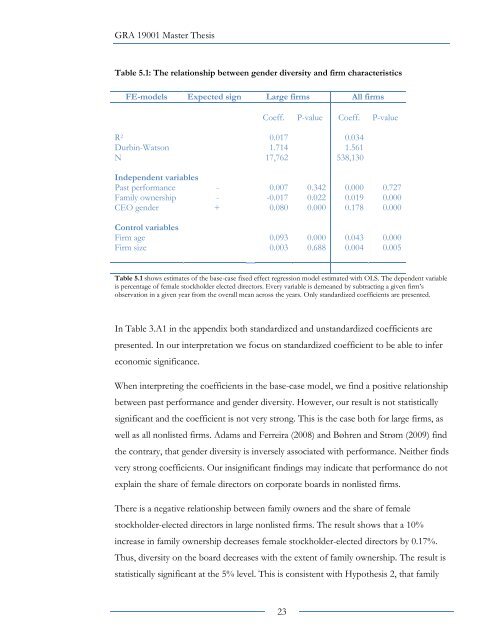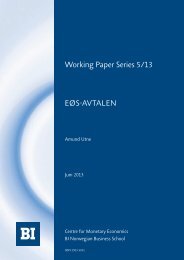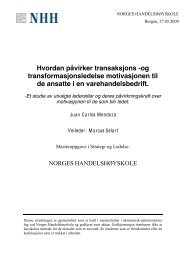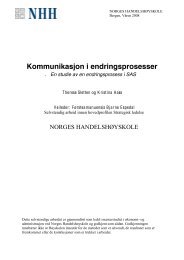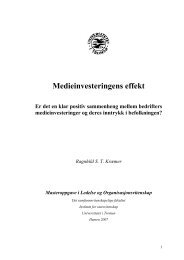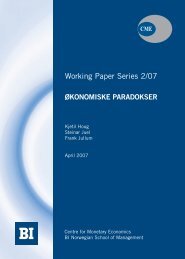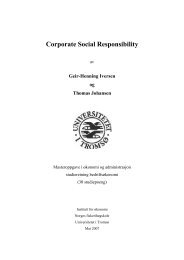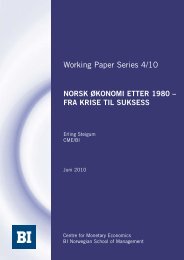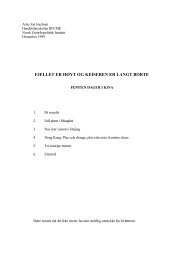Gender Diversity on the Board - BI Norwegian Business School
Gender Diversity on the Board - BI Norwegian Business School
Gender Diversity on the Board - BI Norwegian Business School
You also want an ePaper? Increase the reach of your titles
YUMPU automatically turns print PDFs into web optimized ePapers that Google loves.
GRA 19001 Master Thesis<br />
Table 5.1: The relati<strong>on</strong>ship between gender diversity and firm characteristics<br />
FE-models Expected sign Large firms All firms<br />
Coeff. P-value Coeff. P-value<br />
R 2 0.017 0.034<br />
Durbin-Wats<strong>on</strong> 1.714 1.561<br />
N 17,762 538,130<br />
Independent variables<br />
Past performance - 0.007 0.342 0.000 0.727<br />
Family ownership - -0.017 0.022 0.019 0.000<br />
CEO gender + 0.080 0.000 0.178 0.000<br />
C<strong>on</strong>trol variables<br />
Firm age 0.093 0.000 0.043 0.000<br />
Firm size 0.003 0.688 0.004 0.005<br />
Table 5.1 shows estimates of <strong>the</strong> base-case fixed effect regressi<strong>on</strong> model estimated with OLS. The dependent variable<br />
is percentage of female stockholder elected directors. Every variable is demeaned by subtracting a given firm’s<br />
observati<strong>on</strong> in a given year from <strong>the</strong> overall mean across <strong>the</strong> years. Only standardized coefficients are presented.<br />
In Table 3.A1 in <strong>the</strong> appendix both standardized and unstandardized coefficients are<br />
presented. In our interpretati<strong>on</strong> we focus <strong>on</strong> standardized coefficient to be able to infer<br />
ec<strong>on</strong>omic significance.<br />
When interpreting <strong>the</strong> coefficients in <strong>the</strong> base-case model, we find a positive relati<strong>on</strong>ship<br />
between past performance and gender diversity. However, our result is not statistically<br />
significant and <strong>the</strong> coefficient is not very str<strong>on</strong>g. This is <strong>the</strong> case both for large firms, as<br />
well as all n<strong>on</strong>listed firms. Adams and Ferreira (2008) and Bøhren and Strøm (2009) find<br />
<strong>the</strong> c<strong>on</strong>trary, that gender diversity is inversely associated with performance. Nei<strong>the</strong>r finds<br />
very str<strong>on</strong>g coefficients. Our insignificant findings may indicate that performance do not<br />
explain <strong>the</strong> share of female directors <strong>on</strong> corporate boards in n<strong>on</strong>listed firms.<br />
There is a negative relati<strong>on</strong>ship between family owners and <strong>the</strong> share of female<br />
stockholder-elected directors in large n<strong>on</strong>listed firms. The result shows that a 10%<br />
increase in family ownership decreases female stockholder-elected directors by 0.17%.<br />
Thus, diversity <strong>on</strong> <strong>the</strong> board decreases with <strong>the</strong> extent of family ownership. The result is<br />
statistically significant at <strong>the</strong> 5% level. This is c<strong>on</strong>sistent with Hypo<strong>the</strong>sis 2, that family<br />
23


